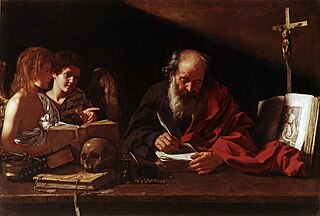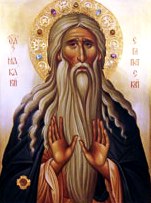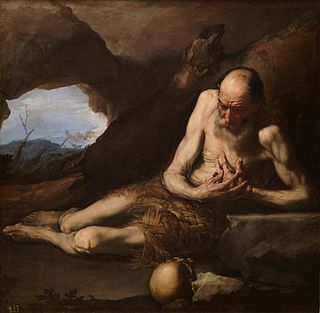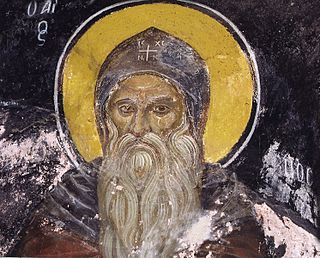
Anthony the Great was a Christian monk from Egypt, revered since his death as a saint. He is distinguished from other saints named Anthony, such as Anthony of Padua, by various epithets: Anthony of Egypt, Anthony the Abbot, Anthony of the Desert, Anthony the Anchorite, Anthony the Hermit, and Anthony of Thebes. For his importance among the Desert Fathers and to all later Christian monasticism, he is also known as the Father of All Monks. His feast day is celebrated on 17 January among the Eastern Orthodox and Catholic churches and on Tobi 22 in the Coptic calendar.

Pachomius, also known as Saint Pachomius the Great, is generally recognized as the founder of Christian cenobitic monasticism. Coptic churches celebrate his feast day on 9 May, and Eastern Orthodox and Catholic churches mark his feast on 15 May or 28 May. In Lutheranism, he is remembered as a renewer of the church, along with his contemporary, Anthony of Egypt on 17 January.

A hermit, also known as an eremite or solitary, is a person who lives in seclusion. Eremitism plays a role in a variety of religions.

Moses the Black, also known as Moses the Strong, Moses the Robber, and Moses the Ethiopian, was an ascetic hieromonk in Egypt in the fourth century AD, and a Desert Father. He is highly venerated in the Eastern Orthodox Church and the Oriental Orthodox Church. According to stories about him, he converted from a life of crime to one of asceticism. He is mentioned in Sozomen's Ecclesiastical History, written about 70 years after Moses's death.

Onuphrius lived as a hermit in the desert of Upper Egypt in the 4th or 5th centuries. He is venerated as Saint Onuphrius in both the Roman Catholic and Eastern Catholic churches, as Venerable Onuphrius in Eastern Orthodoxy, and as Saint Nofer the Anchorite in Oriental Orthodoxy.

Macarius of Egypt was a Christian monk and grazer hermit. He is also known as Macarius the Elder or Macarius the Great.

Christian monasticism is a religious way of life of Christians who live ascetic and typically cloistered lives that are dedicated to Christian worship. It began to develop early in the history of the Christian Church, modeled upon scriptural examples and ideals, including those in the Old Testament. It has come to be regulated by religious rules and, in modern times, the Canon law of the respective Christian denominations that have forms of monastic living. Those living the monastic life are known by the generic terms monks (men) and nuns (women). The word monk originated from the Greek μοναχός, itself from μόνος meaning 'alone'.

Hilarion the Great (291–371) was an anchorite who spent most of his life in the desert according to the example of Anthony the Great (c. 251–356). While Anthony is considered to have established Christian monasticism in the Egyptian Desert, Hilarion is considered by his biographer Jerome to be the founder of Palestinian monasticism and venerated as a saint exemplifying monastic virtues by the Orthodox and the Roman Catholic Church.

John Cassian, also known as John the Ascetic and John Cassian the Roman, was a Christian monk and theologian celebrated in both the Western and Eastern churches for his mystical writings. Cassian is noted for his role in bringing the ideas and practices of early Christian monasticism to the medieval West.

The Desert Fathers were early Christian hermits and ascetics, who lived primarily in the Scetes desert of the Roman province of Egypt, beginning around the third century AD. The Apophthegmata Patrum is a collection of the wisdom of some of the early desert monks and nuns, in print as Sayings of the Desert Fathers. The first Desert Father was Paul of Thebes, and the most well known was Anthony the Great, who moved to the desert in AD 270–271 and became known as both the father and founder of desert monasticism. By the time Anthony had died in AD 356, thousands of monks and nuns had been drawn to living in the desert following Anthony's example, leading his biographer, Athanasius of Alexandria, to write that "the desert had become a city." The Desert Fathers had a major influence on the development of Christianity.

Ammon, Amun, Ammonas, Amoun (Ἀμοῦν), or Ammonius the Hermit was a 4th-century Christian ascetic and the founder of one of the most celebrated monastic communities in Egypt. He was subsequently declared a saint. He was one of the most venerated ascetics of the Nitrian Desert, and Athanasius of Alexandria mentions him in his life of Anthony the Great.

Paul of Thebes, commonly known as Paul the First Hermit or Paul the Anchorite, was an Egyptian saint regarded as the first Christian hermit and grazer, who was claimed to have lived alone in the desert of Thebes, Roman Egypt from the age of 16 to the age of 113 years old. He was canonized in 491 by Pope Gelasius I, and is venerated as a saint by the Catholic Church, Eastern Orthodox Church, and Oriental Orthodox Churches.

Consecrated life is a state of life in the Catholic Church lived by those faithful who are called to follow Jesus Christ in a more exacting way. It includes those in institutes of consecrated life, societies of apostolic life, as well as those living as hermits or consecrated virgins.

Fabius Claudius Gordianus Fulgentius, also known as Fulgentius of Ruspe, was a North African Christian prelate who served as Bishop of Ruspe in what is now Tunisia, during the 5th and 6th century. He is venerated as a saint.

Pambo of Nitria was a Coptic Desert Father of the fourth century and disciple of Anthony the Great. His feast day is July 18 among the Oriental Orthodox, Eastern Orthodox, and Catholic churches.

Viator of Lyons is a Gallic saint of the fourth century.
Amma (Mother) Sarah of the Desert was one of the early Desert Mothers who is known to us today through the collected Sayings of the Desert Fathers and of the Holy Women Ascetics. She was a hermit and followed a life dedicated to strict asceticism for some sixty years.
In the Catholic Church, a religious institute is "a society in which members, according to proper law, pronounce public vows, either perpetual or temporary which are to be renewed, however, when the period of time has elapsed, and lead a life of brothers or sisters in common."
Saint Pior was an Egyptian monk and hermit in the desert of Scetis, one of the Desert Fathers, and a disciple of Anthony the Great. He lived to a great age. His feast day is 17 June.
Or of Nitria was an Egyptian Orthodox Christian ascetic who lived around the 4th century AD in Egypt in Dalga, Nitria, the Thebaid, and in the deserts around Shaina. He is one of the lesser-known Desert Fathers, but is nevertheless regarded as one of the "chief among monks", being "a man who stood out among many of the fathers". He is associated with Theodore and Sisoes the Great. According to Jerome, at one point during his life, Or was the father of "one thousand [cenobitic] monks" in the Egyptian Desert. Or died c. 390.

















